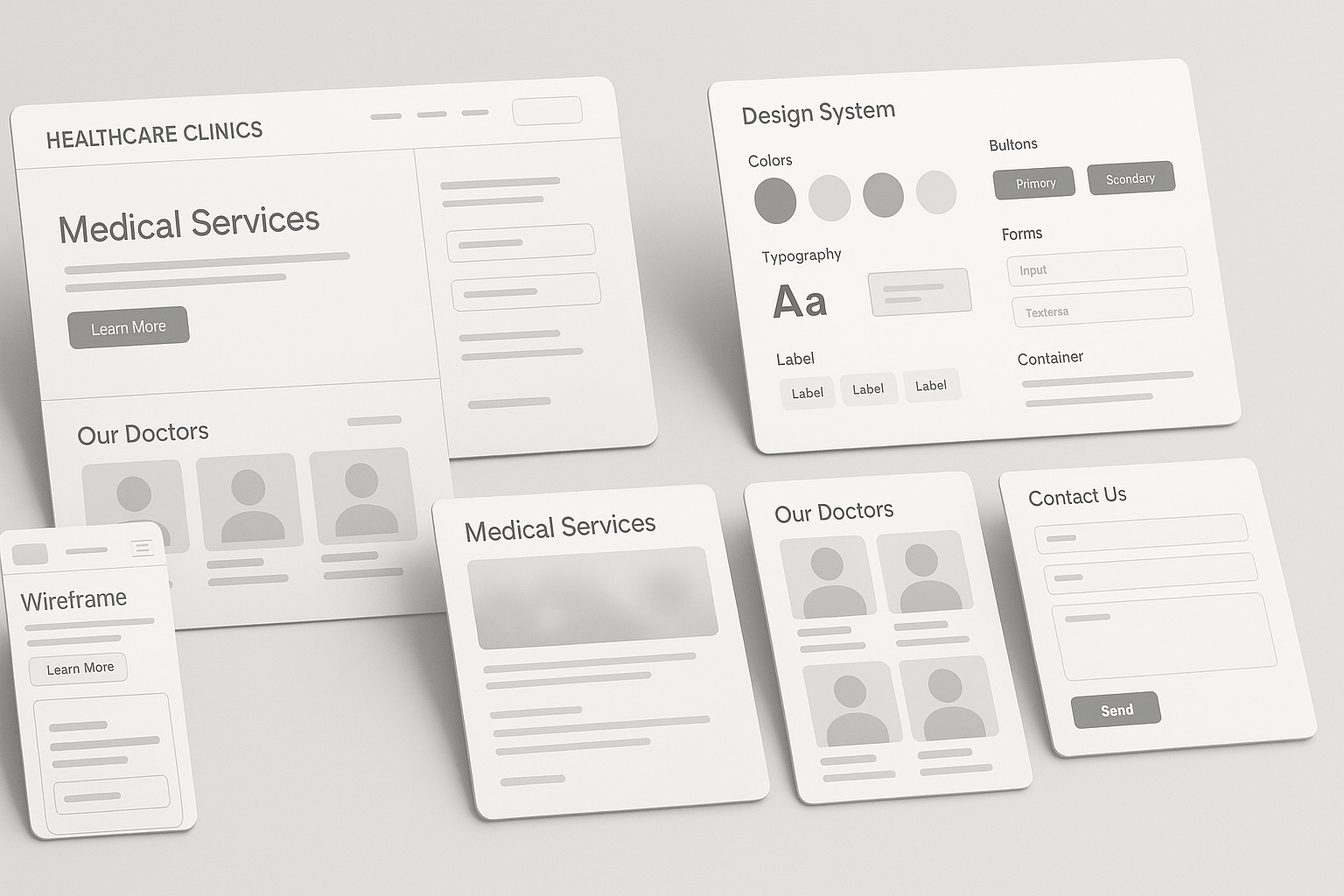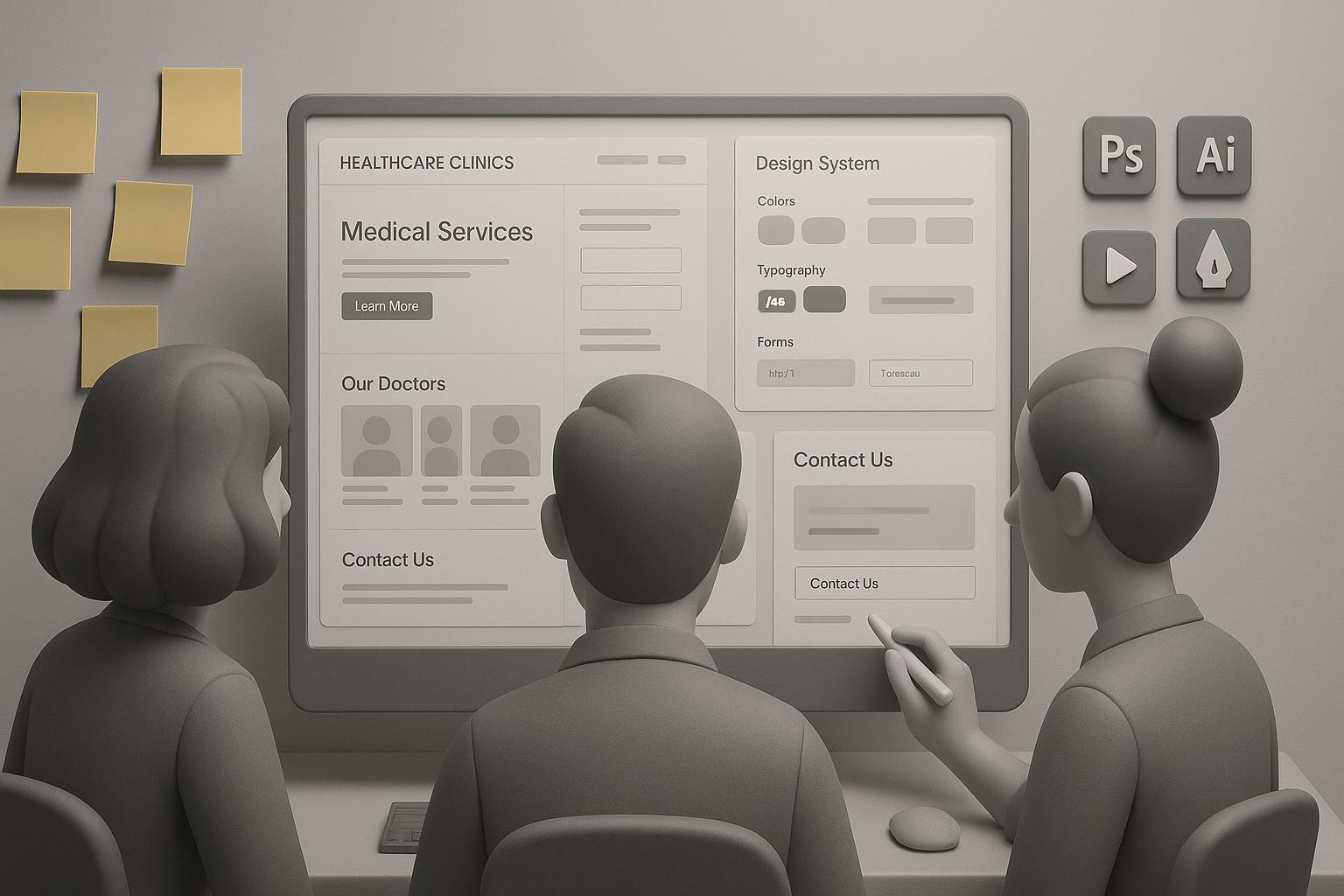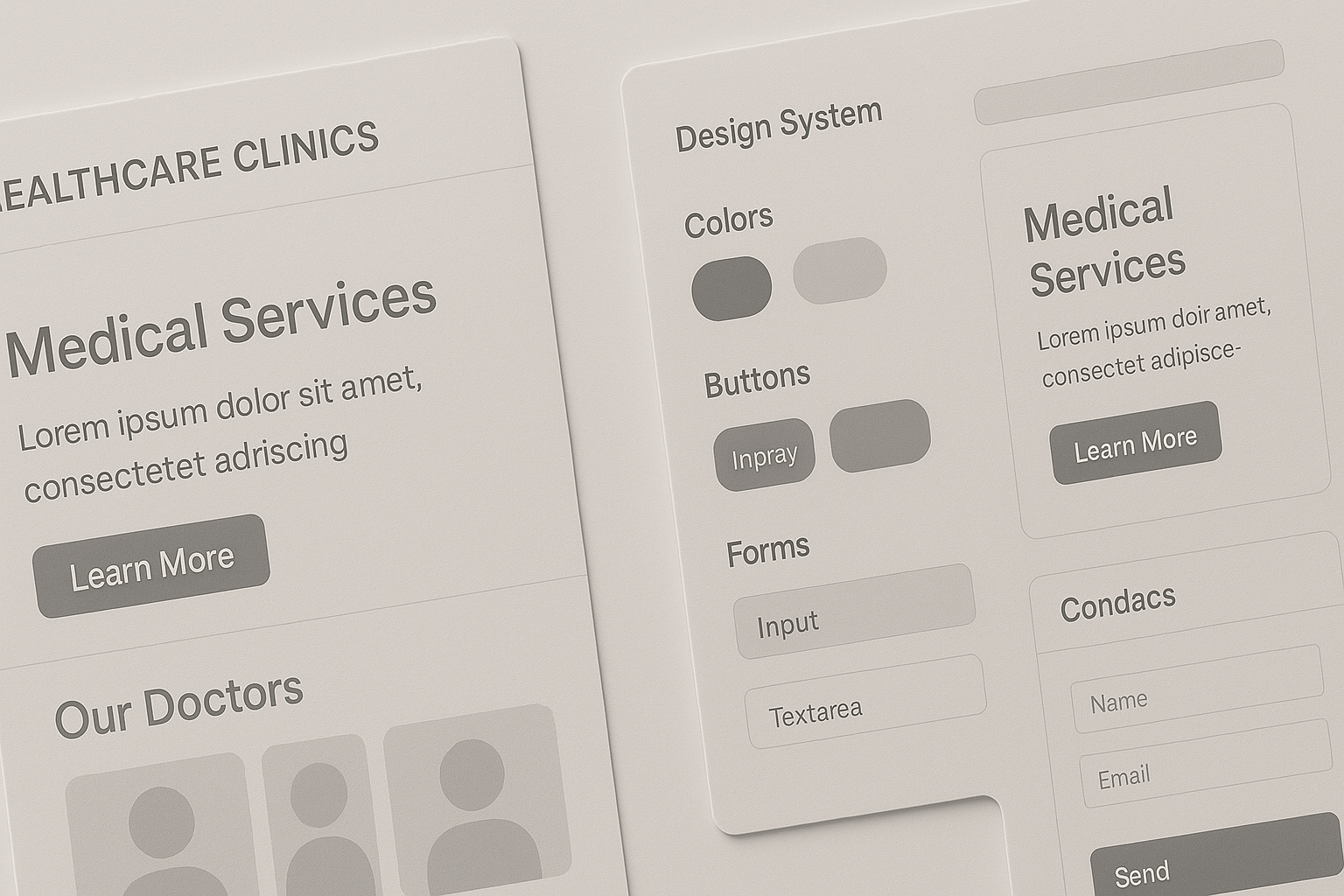Web Design Strategies Every Healthcare Clinic Needs
by Design Delulu Editorial · September 24, 2025

In today's digital-first healthcare landscape, your clinic's website serves as the critical first impression for potential patients. With over 80% of patients researching healthcare providers online before scheduling appointments, having a strategically designed website isn't just beneficial—it's essential for practice growth and patient acquisition.
Healthcare clinics face unique challenges in the digital space, from complex compliance requirements to the need for building trust with vulnerable populations. Effective web design addresses these pain points while creating seamless patient experiences that drive conversions and improve healthcare outcomes.

Why Healthcare Clinics Need Strategic Web Design
Healthcare clinics operate in a highly competitive and regulated environment where trust, accessibility, and efficiency are paramount. Without proper web design, clinics struggle with several critical challenges:
Key Challenges Healthcare Clinics Face
- Patient Acquisition Difficulties: Traditional marketing methods are becoming less effective as patients increasingly turn to online research. Clinics without strong digital presence lose potential patients to competitors with more accessible, professional websites.
- Trust and Credibility Issues: Healthcare is fundamentally built on trust. A poorly designed website with outdated information, broken links, or unprofessional appearance immediately undermines patient confidence before they even step through your doors.
- Operational Inefficiencies: Manual appointment scheduling, phone-only communication, and paper-based processes create bottlenecks that frustrate both patients and staff, leading to missed appointments and reduced patient satisfaction.
- Compliance and Security Concerns: Healthcare websites must navigate complex HIPAA requirements while maintaining user-friendly experiences, a balance many clinics struggle to achieve without proper design expertise.
How Strategic Web Design Solves These Problems
Professional web design transforms these challenges into competitive advantages by creating digital experiences that attract, convert, and retain patients while streamlining clinic operations.
- Enhanced Patient Acquisition: SEO-optimized websites with local search optimization help clinics appear when potential patients search for healthcare services in their area, significantly increasing qualified lead generation.
- Trust Building Through Design: Professional layouts, patient testimonials, provider credentials, and security badges create immediate credibility, while clear service descriptions help patients understand treatment options.
- Streamlined Operations: Integrated appointment booking systems, patient portals, and automated communication tools reduce administrative burden while improving patient convenience and satisfaction.
- Compliance-First Approach: Properly designed healthcare websites incorporate HIPAA-compliant contact forms, secure patient portals, and privacy-focused analytics that protect patient information while gathering valuable insights.

Essential Features of Web Design for Healthcare Clinics
Successful healthcare website design requires specific features that address both patient needs and regulatory requirements while supporting business growth.
Must-Have Design Elements and Tools
- Responsive Mobile Design: With over 60% of healthcare searches happening on mobile devices, your website must provide seamless experiences across all screen sizes. This includes touch-friendly navigation, readable fonts, and fast loading times on mobile networks.
- Online Appointment Scheduling: Integrated booking systems that sync with practice management software eliminate phone tag while allowing patients to schedule appointments 24/7. Include features for appointment reminders and easy rescheduling options.
- Patient Portal Integration: Secure portals where patients can access test results, prescription information, and communicate with providers improve patient engagement while reducing administrative calls.
- Service-Specific Landing Pages: Dedicated pages for each service or specialty help with SEO while providing detailed information that helps patients make informed decisions about their care.
- Provider Profiles and Credentials: Detailed biographies, educational backgrounds, specializations, and professional photos help patients choose the right provider for their needs while building trust through transparency.
Real-World Implementation Examples
- Multi-Location Clinic Success: A regional clinic chain implemented location-specific landing pages with unique service offerings, provider information, and local contact details, resulting in a 150% increase in appointment bookings across all locations.
- Specialty Practice Growth: A dermatology clinic added before/after photo galleries, detailed procedure explanations, and virtual consultation options, leading to a 200% increase in cosmetic procedure inquiries within six months.
- Urgent Care Efficiency: An urgent care center integrated real-time wait time displays and online check-in capabilities, reducing patient wait times by 40% while improving patient satisfaction scores.

Common Mistakes to Avoid in Healthcare Web Design
Even well-intentioned healthcare websites can fail to achieve their goals due to common design and strategy mistakes that undermine user experience and business objectives.
Typical Pitfalls in Healthcare Web Design
- Generic Stock Photography: Using obvious stock photos of smiling models in lab coats creates a disconnect with real patients and fails to showcase your actual facility and staff. This approach makes clinics appear impersonal and generic.
- Information Overload: Cramming too much medical information onto single pages overwhelms patients and makes it difficult to find specific information. Complex medical jargon without plain-language explanations further alienates potential patients.
- Neglecting Local SEO: Failing to optimize for local search terms, missing Google My Business integration, and lacking location-specific content prevents clinics from appearing in local search results when patients need immediate care.
- Poor Mobile Experience: Non-responsive designs, slow loading times, and difficult-to-use mobile navigation frustrate patients who increasingly use mobile devices for healthcare searches and appointment booking.
- Compliance Oversights: Inadequate privacy policies, non-HIPAA compliant contact forms, and missing accessibility features can result in legal issues while creating barriers for patients with disabilities.
How to Do Better
- Authentic Visual Content: Invest in professional photography of your actual facility, staff, and equipment. Show real patients (with proper consent) to create authentic connections that build trust and familiarity.
- Structured Information Architecture: Organize content using clear hierarchies, logical navigation, and patient-centered categorization. Use plain language explanations alongside medical terms to ensure accessibility for all education levels.
- Local SEO Optimization: Implement comprehensive local SEO strategies including location-based keywords, Google My Business optimization, local directory listings, and location-specific content that addresses community health needs.
- Mobile-First Design Approach: Design for mobile devices first, then enhance for larger screens. Prioritize fast loading times, thumb-friendly button sizes, and simplified navigation that works well on small screens.
- Proactive Compliance Strategy: Work with healthcare compliance experts to ensure all website features meet HIPAA requirements, ADA accessibility standards, and state-specific healthcare regulations from the design phase forward.
SEO and Growth Best Practices for Healthcare Clinics
Effective healthcare website optimization goes beyond basic SEO to address the unique search behaviors and needs of healthcare consumers while building sustainable organic growth.
Healthcare-Specific Optimization Strategies
- Local Health Topic Authority: Create comprehensive content around health conditions common in your geographic area, seasonal health concerns, and preventive care topics that position your clinic as a trusted local health resource.
- Voice Search Optimization: Optimize for conversational queries like "family doctor near me accepting new patients" and "urgent care open now" as voice search becomes increasingly important for immediate healthcare needs.
- Schema Markup Implementation: Use healthcare-specific structured data to help search engines understand your services, provider information, accepted insurance plans, and operating hours for enhanced search result displays.
- Patient Review Integration: Implement systems for collecting and displaying patient reviews while maintaining HIPAA compliance. Positive reviews significantly impact local search rankings and patient decision-making.
- Content Marketing for Patient Education: Develop regular blog content addressing common patient questions, seasonal health tips, and preventive care information that demonstrates expertise while improving search visibility.
Leveraging Web Design for Visibility and Results
- Conversion-Focused Design Elements: Strategic placement of appointment booking buttons, clear calls-to-action, and prominent contact information throughout the site maximize the likelihood of converting website visitors into patients.
- Performance Optimization: Fast-loading websites rank better in search results and provide better user experiences. Optimize images, minimize code, and use content delivery networks to ensure quick loading times across all devices.
- Analytics and Tracking Setup: Implement comprehensive tracking to monitor patient acquisition channels, popular content, and conversion paths. This data informs ongoing optimization strategies and marketing budget allocation.
- Social Proof Integration: Display patient testimonials, awards, certifications, and community involvement prominently to build trust and credibility that supports both SEO efforts and conversion optimization.
Advanced Strategies for Healthcare Website Success
Beyond basic design and optimization, successful healthcare websites implement advanced strategies that create competitive advantages and drive long-term growth.
Patient Experience Innovation
- Telemedicine Integration: Seamlessly integrated telehealth capabilities allow patients to access care remotely while expanding your practice's reach beyond geographic limitations.
- AI-Powered Symptom Checkers: Interactive tools that help patients understand when to seek care while directing them to appropriate services within your clinic create value while generating qualified leads.
- Personalized Patient Journeys: Dynamic content that adapts based on patient demographics, previous interactions, and service interests creates more relevant experiences that improve engagement and conversion rates.
Technology Integration for Operational Efficiency
- Practice Management System Synchronization: Direct integration between your website and practice management software eliminates double data entry while ensuring accurate scheduling and patient information management.
- Automated Patient Communication: Automated appointment confirmations, reminders, and follow-up communications reduce no-shows while improving patient satisfaction through consistent communication.
- Real-Time Insurance Verification: Integration with insurance verification systems helps patients understand coverage and costs upfront, reducing billing issues and improving patient satisfaction.
Measuring Success and Continuous Improvement
Effective healthcare website design requires ongoing monitoring and optimization to ensure continued success in achieving patient acquisition and operational efficiency goals.
Key Performance Indicators for Healthcare Websites
- Patient Acquisition Metrics: Track new patient appointments generated through website interactions, cost per acquisition across different marketing channels, and conversion rates from website visitors to scheduled appointments.
- Patient Experience Indicators: Monitor website engagement metrics like time on site, pages per session, and bounce rates alongside patient satisfaction scores and online review ratings.
- Operational Efficiency Measures: Measure the impact of online scheduling systems, patient portal usage rates, and reduction in administrative phone calls to quantify operational improvements.
Continuous Optimization Strategies
- A/B Testing for Healthcare: Test different appointment booking flows, call-to-action placements, and service page layouts to identify what resonates most with your patient population.
- Regular Content Auditing: Systematically review and update medical information, service descriptions, and provider details to ensure accuracy and relevance while maintaining search engine rankings.
- User Experience Research: Conduct patient surveys and usability testing to identify pain points and opportunities for improvement in the digital patient experience.
Future-Proofing Your Healthcare Website
The healthcare industry continues to evolve rapidly, with new technologies, regulations, and patient expectations creating both opportunities and challenges for clinic websites.
Emerging Trends in Healthcare Web Design
- Voice Interface Integration: As smart speakers and voice assistants become more common, healthcare websites must prepare for voice-based interactions and queries.
- AI-Powered Personalization: Machine learning algorithms that customize website experiences based on patient behavior and preferences will become increasingly important for engagement and conversion.
- Enhanced Security Measures: Growing cybersecurity threats require implementing advanced security measures beyond basic HIPAA compliance to protect patient data and maintain trust.
Preparing for Regulatory Changes
- Privacy Law Evolution: Stay informed about evolving privacy regulations beyond HIPAA, including state-specific laws and international requirements if serving diverse patient populations.
- Accessibility Standards: Proactively implement accessibility features that exceed current ADA requirements to ensure your website remains compliant as standards become more stringent.
- Telehealth Regulation Adaptation: Monitor changing telehealth regulations and ensure your website's integrated telemedicine features comply with evolving state and federal requirements.
Ready to improve your healthcare clinic's digital presence with strategic web design? Professional healthcare website design combines regulatory compliance, patient-centered experiences, and growth-focused optimization to create competitive advantages that drive sustainable practice growth.
Transform your healthcare practice today. Strategic web design for healthcare clinics requires specialized expertise in both digital marketing and healthcare industry requirements. Partner with experienced healthcare web design professionals who understand the unique challenges and opportunities in healthcare digital marketing.
👉 Explore Web Design at Design Delulu